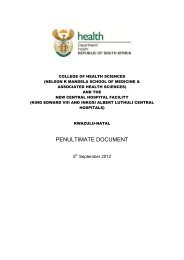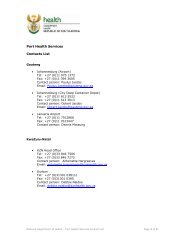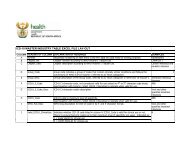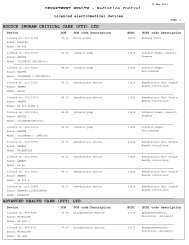National Norms and Standards relating to Environmental Health
National Norms and Standards relating to Environmental Health
National Norms and Standards relating to Environmental Health
You also want an ePaper? Increase the reach of your titles
YUMPU automatically turns print PDFs into web optimized ePapers that Google loves.
SECTION 14:MONITORING OF DRINKING WATER QUALITY DURING EMERGENCIES / DISASTERS1. During emergencies, in cases of relocation of settlements, people affected by the emergency/disastermust be provided with an adequate supply of potable water <strong>and</strong> sanitation facilities.2. Drinking water supplied in emergencies or disasters situations must conform <strong>to</strong> the specifications asset out in the SANS 241 with regards <strong>to</strong> bacteriological, chemical <strong>and</strong> physical quality.3. If tankers are used, care must be taken <strong>to</strong> ascertain that they are suitable for delivering safe drinkingwater <strong>and</strong> it must first be disinfected before used for potable water distribution.4. Tankers must be loaded with water from a treated supply.5. EHPs should moni<strong>to</strong>r water supply closely during emergencies for safety of consumption. Moni<strong>to</strong>ringshould include sanitary inspections, water sampling <strong>and</strong> analysis <strong>and</strong> moni<strong>to</strong>ring of water treatmentprocesses.6. A risk management approach should be implemented in emergencies in order <strong>to</strong> draw a risk profile <strong>to</strong>direct resources <strong>and</strong> interventions where required.7. EH should ensure that a community affected by an emergency is made aware of <strong>and</strong> educated on thefollowing:• The risks <strong>to</strong> health of the use of contamination of water,• Possible contamination of water from the collection point <strong>to</strong> the point of use,• The means <strong>to</strong> reduce or eliminate risks e.g. household treatment of water.8. During an emergency, where there is a concern about drinking water quality that cannot beaddressed through conventional treatment processes, then household treatment methods must alsobe evaluated <strong>and</strong> implemented.9. EHPs, <strong>Health</strong> Promoters <strong>and</strong> other stakeholders charged with the responsibility of providing health<strong>and</strong> hygiene education, should educate the community affected, <strong>and</strong> those that use unimprovedwater sources on the following household treatment methods:• Boiling water <strong>and</strong> cooling before consumption.• Adding sodium or calcium hypochlorite solution, such as household bleach (one teaspoon) <strong>to</strong> a20-25 litres bucket of water, mixing thoroughly <strong>and</strong> allow <strong>to</strong> st<strong>and</strong> for about 30 min prior <strong>to</strong>consumption, turbid water should be clarified by settling <strong>and</strong>/or filtration before disinfection.• Using sunlight or Solar Disinfection (SODIS) method for drinking water by vigorously shakingsmall volumes of water in a clean, transparent container, such as a soft drink bottle, for 20seconds <strong>and</strong> exposing the container <strong>to</strong> sunlight for at least 6 hrs.• Applying other approved products such as tablets, or other dosing techniques <strong>to</strong> disinfect thewater, with or without clarification by flocculation or filtration.10. Chemicals used for the household/emergency of water must be approved by the Department of<strong>Health</strong>; <strong>Environmental</strong> <strong>Health</strong> prior <strong>to</strong> its use by the consumers <strong>to</strong> assess the sustainability of suchchemical such that it does not cause harm <strong>to</strong> human health.11. Containers that are hygienic <strong>and</strong> appropriate <strong>to</strong> local needs <strong>and</strong> habits should be available for thecollection <strong>and</strong> s<strong>to</strong>rage of water <strong>to</strong> be used for washing, cooking <strong>and</strong> bathing at household level.12. Adequate sanitation facilities must available for use by people affected by disasters/ emergency.13. EHPs must ensure that indiscriminate defaecation is strongly discouraged, especially where watersources are close <strong>to</strong> dwelling areas <strong>and</strong> in high density areas.14. Moni<strong>to</strong>ring of water quality in emergencies should also include water quality assessment <strong>and</strong> theinvestigation of disease outbreaks, or the evaluation of hygiene promotion activities as required.15. During an emergency, water must be closely moni<strong>to</strong>red for residual chlorine at the treatment works.To ensure proper levels of turbidity <strong>and</strong> drinking water must be disinfected <strong>and</strong> an adequatedisinfectant (residual chlorine) must be maintained in the system.16. <strong>Health</strong> information should be moni<strong>to</strong>red <strong>to</strong> ensure that water quality can be rapidly investigated wherethere is a possibility that water quality may contribute <strong>to</strong> a health problem <strong>and</strong> that treatmentprocesses, particularly disinfection –can be modified as required.Emergency management/response planning1. EHPs in collaboration with other role-players should ensure that an emergency management plan/emergency response plan is in place for emergencies such a sewage leaks, spillages <strong>and</strong> floods,should an emergency occur.DOH. <strong>Norms</strong> <strong>and</strong> st<strong>and</strong>ards for environmental health in South Africa Feb 2013 105



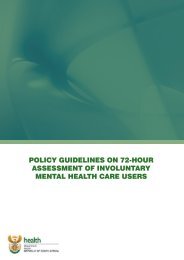
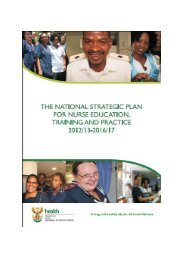
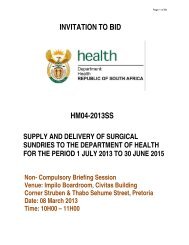
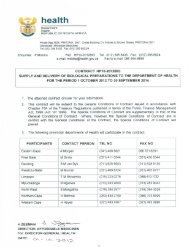
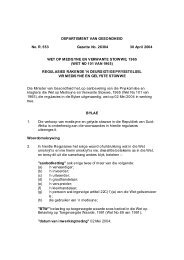
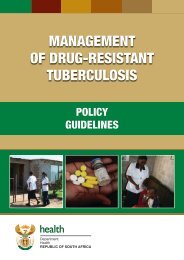
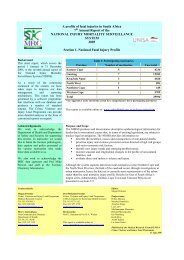
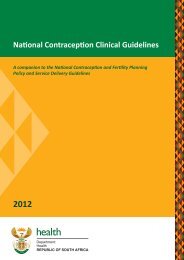
![A monograph of the management of postpartum haemorrhage [2011]](https://img.yumpu.com/15578784/1/184x260/a-monograph-of-the-management-of-postpartum-haemorrhage-2011.jpg?quality=85)
